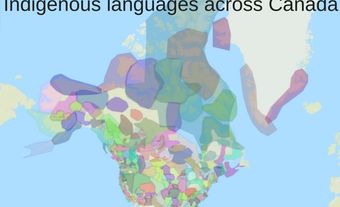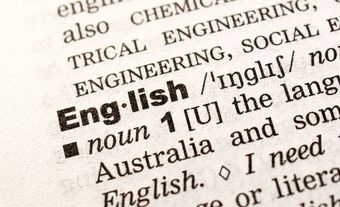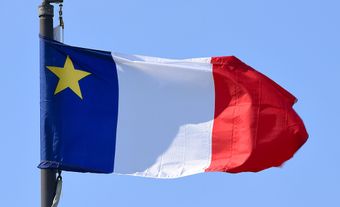Language is a form of communication. More specifically, language is a communication system based on human sounds. There are, however, other forms of communication systems based on touch, scent, movement, colour, gesture and even the electrical impulses that pass through computers.
Did you know? Animals have their own forms of language. For example, a bee can communicate the location of nectar by performing a dance for other bees in the hive. A peacock can communicate by displaying brightly coloured feathers and strutting about. However, such forms of communication differ from the complexity of human language.
Before it can become a form of communication, a language must have become a system of representation. A system of representation is necessary if the meanings of its words and sentences are to be understood by people communicating in the same language, that is, by using the same code.
Languages as Codes
It can help to think of languages in terms of codes. Different languages, such as French, English, Cree or Anishinaabemowin/Ojibwe for example, code things in different ways. Anything that can be seen, heard, felt, experienced or conceived can be coded in any way by language. There is no necessary relationship between what is seen and what is heard in language. For example, there is no reason why a particular animal should be called chien in French, hund in German, perro in Spanish, kutya in Hungarian or dog in English. It is necessary, however, that for people speaking the same language, these words always refer to the same animal.
We know that all people using the streets and roads of a city must accept the convention that a red traffic light means "stop." In this sense, language is a system of conventional signs, even though the signs may be arbitrary at first. Not only are these signs arbitrary; so is what they represent. For example, English has different words for inside barriers, as opposed to outside barriers - doors are distinguished from gates. French, on the other hand, uses one word, portes, for both. French distinguishes between two sorts of rivers, fleuve and rivière, while English uses one word for both.
Each language explains the world, or an experience of the world, in it’s own way. For example, although people who speak different languages may see the same rainbow in the same way, the number and range of the rainbow's hues they can name will depend on how colours have been coded in their language. Some languages have everyday words for a dozen colours; other language can get by with only a couple. The difference could be between light and dark, or reddish and bluish. In other words, different languages explain the same observable reality - the same rainbow, in this case - in different ways. The line of demarcation between blue and green in the Germanic language is not the same as it is in the Celtic language; some things that are blue in English may be green in Welsh. Languages differ in the number, type and contents of their categories.
There are some universal features of human language that distinguish it from other forms of communication. Perhaps most important is what linguists refer to as "productivity," a feature implying that there are no limitations to what speakers can express through language. Humans can talk about anything; we are able to create, speak and understand sentences that have never been heard before.
The Components of Language
To categorize things, events and ideas, a language employs syntax (including word order), morphology (word roots, affixes), phonology (functional sounds) and prosody (intonation, stress, tone). What is expressed in one language by differences among words may be expressed in another language by differences in grammar or even intonation. For example, the difference between the French words personne and n'importe qui can be rendered in English by a difference in the intonation of such utterances as "I don't lend my books to anyone" ( "je ne prête pas mes livres à - personne/n'importe qui").
Natural vs Artificial Languages
A further distinction within the concept of language should be made between natural and artificial languages. Some artificial languages were invented in response to a desire for a universal medium of communication. Esperanto, Novial, Interlingua and several hundred other artificial languages have been proposed over the past few centuries, but none of them has met with universal acceptance. Computer technology has brought about another kind of artificial language: Fortran, Basic and Cobol have been some of the codes with which humans can communicate with machines, but none of them is nearly as elaborate as a natural language (see also Artificial Intelligence in Canada). Natural languages have evolved within communities, some of them over many millennia; they are all based on human speech sounds, except for sign languages (used mainly by the hearing impaired) and purely idiographic writing systems (characters or symbols that represent an idea or thing). An infant surrounded by people who speak a particular language will learn that language, just as they learn the behaviours expected by family and community.
Language, Culture and Society
Language, like religion, social behaviour, dress, food or custom, is an integral component of culture. It can help to think of language as a living monument built by generations of speakers, one that has encoded everything that its speakers have considered important while leaving out anything considered unimportant. For example, Inuit communities moving through the treeless fringes of the Arctic seas historically had little need to distinguish different types of trees; what they needed were words to talk about different types of snow. In some Inuit dialects, more than 50 words referring to ice and snow are in use (see also Arctic Indigenous Peoples in Canada; Arctic Exploration). All cultures have words that reflect their needs.
Although language is one component of culture, not all cultures regard language in the same way. For some, language is a deep seated marker of identity, something that must be protected and kept “pure.” For others, language is approached as a resource, a skill required to communicate, to get a job and make a living. (See also Canadian Language and Identity; Francophone; Anglophone; Allophone.)
Language, Dialect and Register
No two people speak the same language in exactly the same way. Every individual has an idiolect (their own individual speech habits), yet within any speech community the degree of individual difference cannot be such as to make mutual comprehension impossible. Groups of people who communicate frequently develop a common speech and a threshold of tolerance for individual speech differences. Consequently, people living in the same region are likely to speak in a similar way. In other words, they speak the same dialect.
Dialects have traditionally been described along two parameters, geographic and social. Just as people tend to speak in a manner similar to that of those living nearby, their speech usually resembles that of their socioeconomic peers with whom they usually associate. An example of a dialect based on social position is the British RP ("received pronunciation"), the "public school" accents of English as spoken by the people educated in the private schools of Great Britain. Language also varies in degree of formality depending on the context and occasion, and on the relative familiarity of the speakers. Thus many people use a number of different registers. What is appropriate in speaking to a family member may not be acceptable to a group of strangers at a public meeting or when addressing a judge in court.
Languages of the World
The difference between adjacent speech communities is one of degree. As such, linguists have not always agreed on what dialect belongs to which language. There is even some debate as to whether a given dialect is, in fact, a separate language. Recognition of a dialect as a language is a matter of circumstance. In the past, the dialect of the royal court, the capital city or the seat of national government was usually selected as a state's language. Today, linguists seek more objective criteria for recognizing or categorizing a language or dialect. Languages are described as mutual unintelligibility to emphasize that knowledge of one language does not preclude knowledge with another language. If two speech communities can understand each other, they are commonly thought to speak varieties of the same language, whereas two communities using mutually unintelligible speech might claim to be speaking two different languages or dialects. This is one way in which language distinctions are made today, although political boundaries still have an influence on linguistic classification.
Languages are grouped into families, the most encompassing (a phylum) being a number of languages that have all developed historically from the same protolanguage (source language). There are several such language family groups in the world, including Sino-Tibetan, Afro-Asiatic, Uralic-Altaic, Austronesian and Uto-Aztecan. There are around 70 distinct Indigenous Languages in Canada, falling into 12 separate language families. One of the world's largest and most widespread group of language families is the Indo-European phylum which included families such as the Germanic, the Romance and the Slavic. The English language belongs to the so-called Germanic branch of this family, as do German, Dutch, Yiddish, Danish, Icelandic and many others. French belongs to the Romance family, which includes also Latin, Italian, Portuguese, Spanish, Romanian and others.
Language Change
Language differentiation is a function of time and space. When a group of people emigrates from its home community, the farther away it goes and the longer it remains isolated, the more different its language might become from that spoken in the area of origin. Although related languages may be mutually incomprehensible, it is possible, using techniques of comparative reconstruction, to establish sound-to-sound and word-to-word relationships even if the speakers have lived apart for a thousand years or more. The same techniques that permit the identification of related languages also show how one language evolves into another. By comparing forms of the same word in documents of different dates, linguists have demonstrated, for example, the conditions under which the Latin of the Roman legions and their subjects developed into Spanish in Spain, French in France and Romanian in Romania. The process continues today. A good example of this is the Haitian language. On the early plantations of Haiti, the African slaves speaking mutually incomprehensible languages developed their own simplified version of the speech of their French-speaking supervisors; in a few generations, this Creole developed into the vernacular of all Haitians.
Did you know? Compared to other forms of French spoken in Canada, many varieties of Acadian French are considered quite traditional in their form and structure. One reason for this is because Acadia was cut off from France in the early 18th century. Even during the French colonial period, contact with people from France, including colonial administrators, was limited. As a result, Acadian French has characteristics that were typical of the French spoken in the 16th and 17th centuries, but that have disappeared from the French spoken by other communities across North America, France and beyond.
Official Languages
A nation in which many languages are spoken may choose to do all its legal, administrative and other official business in one or more official languages. Canada, which has a great many languages as a result of its indigenous and immigrant populations, has adopted two, English and French (see Official Languages Act (1969); Official Languages Act (1988) ). A language may be official according to two principles, the principle of territoriality and the principle of personality. According to the first, it is the individual who accommodates to the language of the state. According to the second, it is the state that accommodates to the language of the individual. The principle of territoriality was adopted for the first time in 1974 as the basis for Quebec's Official Languages Act. By contrast, in 1969 both Canada and New Brunswick had formalized through their Official Languages Acts the application of the principle of personality in all dealings, in English or French, between the government and its citizens.
See also Bilingualism; Immigrant Languages in Canada; Languages in Use in Canada; Linguistics; Translation.

 Share on Facebook
Share on Facebook Share on X
Share on X Share by Email
Share by Email Share on Google Classroom
Share on Google Classroom



